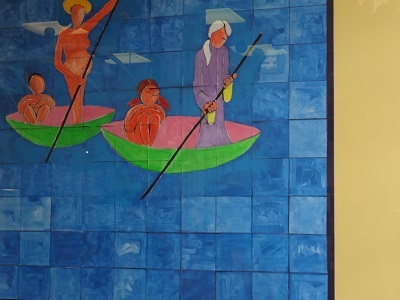Two boats made of fruit shells floating amidst a background of a bright blue sea. Two vessels carrying the symbolism of human existence through its evolution. A pregnant woman and a boy in one, a grandmother with a girl in the other. The path of life through childhood, maturity and old age as it is etched on the faces of people of different races. Entitled "Mother and Child," by local Montrealer artist Nicholas Voeikoff-Erens, this impressive, expansive painting, was officially launched last week. Decorating the entrance to Hopital Ste. Justine, the Francophone pediatric hospital of the city, the work was presented at a small gathering in the presence of the artist and the hospital's director, Fabrice Brunet.
With its bright, radiant colors, the painting immediately evokes the child-friendly atmosphere of the hospital as well as depicting the strong bonds that exist between mother and child. Commemorating the 100th anniversary of the founding of the hospital, it is also a tribute to the many rich hues and cultures that make up Montreal society.
While attending the launch, I had the opportunity to sit down with Voeikoff-Erens and get a closer perspective about his new creation and about the artist himself.
What inspired you?
"The piece began as an idea from the discussion I had with the hospital director, two years ago. He wanted me to know about the hospital, that it had just celebrated its hundredth year and that it is a hospital dedicated to the concept of mother and child, of which there are many around the world. I had the idea to make a painting about "mothers and childhood" rather than the usual "Madonna and child" portraits. I was more interested in the element of time and aging and the cycle of life."
What is the symbolism of the painting?
"Beginning with the cycle of life, I chose to put the figures on a blue background to symbolize space, water and air, our blue planet. There are four characters, two in one vessel, two in the other. In each there is one adult and one child. The little boats are just hemispheres, like half of the earth, green outside, hot (pink) inside. The adults are standing and guiding the boats. The first boat is navigated by an old woman, a grandmother, and with her is a girl. This girl is in the center of the painting. She will soon be a woman and will rise to take the place of the tired grandmother. The other little hemisphere is just behind the first and in it is a pregnant mother and her young son.
The mother in the second boat is sure of her duties. Her child is looking at her only. The characters are not meant to be real people but rather representatives of the stages of life from childhood to old age, dependence and responsibility. The boats and the oars are the technology that humanity needs to survive as a species."
How does an urban painter perceive a children's hospital?
"A children's hospital is a public space, one dedicated to caring for and supporting life, the human family."
Why paint on old newspapers?
"Newspaper is an artifact of the public sphere, a public voice, a public space, a forum for public exchange of ideas and products. I paint over this public space because I believe that by covering up or shutting out the public voice or face, I can achieve a personal space, a place for the self, where real experience is possible over the public one which is media, second hand, manufactured for consumers."
How does it feel to have your painting adorning the front entrance of a children's hospital? Can it be a moment of hope or inspiration for the sick children? Did you feel you bore a heavy burden of responsibility as the artist?
"I am very pleased with the possibility because it is a challenge for me to paint for a public. My painting has always been focused on revealing a space for personal experience. Because I am doing this for a place where children and their families come for help and therapy, my painting is a blend of symbols and simple design and accessible colors. It was a challenge to make an easy-to-look-at picture about how simple life really is. Everybody can see themselves in it. I do feel it is my responsibility to make a picture that is both positive and truthful."
How does it feel for an artist to be commissioned to make a work of art? Does is strip him from the liberty of art itself?
"I am always reminded that artists for centuries have made work on a commission. It is really since the romantic period of the 19th century in Europe that modern painters have made paintings to fulfill themselves first and then the marketplace. The freedom to paint or not to paint is entirely my own. It was my choice to make the painting for which I was invited by the hospital."
What is Nick doing now? Any new path in his urban art?
"I am working at my studio on new work which addresses another approach to dealing with the public "face". I am using masking tape to obscure what newspapers, magazines and advertising are trying to sell to us. My painting is made on two sides, like the paper I paint over, so that you can turn it around and look at from another side. I do not make rigid rectangles that only face out, I make painting that you can touch and turn and twist and hang in any position you wish."
Photo: Justine Frangouli-Argyris

